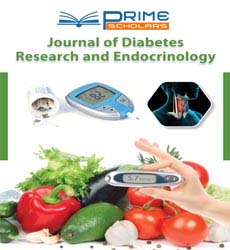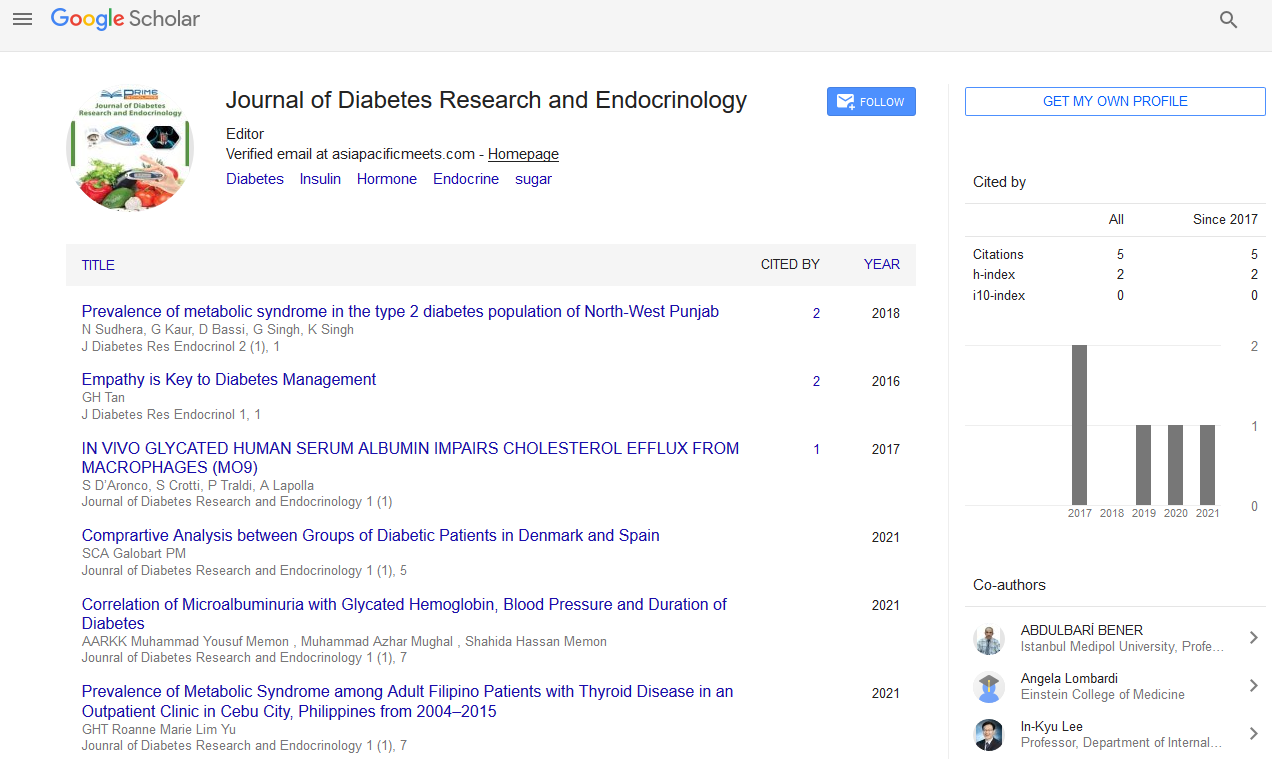Jack Walton*
Department of Medicine, University of Osmania, Hyderabad, Telangana, India
- *Corresponding Author:
- Jack Walton
Department of Medicine,
University of Osmania,
Hyderabad,
Telangana,
India,
E-mail: jackwalton@gmail.com
Received Date: November 8, 2021; Accepted Date: November 22, 2021; Published Date: November 29, 2021
Citation: Walton J (2021) Deficiency of Diabetes Insipidus by Vasopressin. J Diabetes Res Endocrinol Vol.5 No.S2:001.
Description
Diabetes Insipidus (DI) is a condition characterized by large
amounts of dilute urine and increased thirst. The amount of
urine produced can be almost 20 liters per day. The fluid
reduction has little effect on the urine concentration.
Complications can be dehydration. There are four types of DI,
each with different causes: The Central Diabetes Insipidus (CDI)
is caused by a deficiency in the hormone vasopressin
(antidiuretic hormone). This could be due to an injury to the
hypothalamus or pituitary gland, or genetics. NDI) occurs when
the kidneys do not respond adequately to vasopressin.
Dipsogenic Diabetes Insipidus (DDI) is the result of excessive
fluid intake due to damage to the hypothalamic thirst
mechanism. It is more common in people with certain
psychiatric disorders or who are taking certain medications.
Gestation Ti occurs only during pregnancy. The term "diabetes"
is derived from the Greek word "siphon". The subject of
excessive and extreme thirst and increased fluid intake
(especially with cold water and sometimes ice water) is typical,
but the risk remains persistent. Electrolyte and volume
homeostasis is a complex mechanism that balances the body's
need for blood pressure and the key electrolytes, sodium and
potassium. The volume is greatly reduced, the body stores water
at the expense of changes in the level of electrolytes. The
regulation of urine production occurs in the hypothalamus,
which produces ADH in the supraoptic and paraventricular
nuclei. The hormone is transported in neuro-secretory granules
through the axon of the hypothalamic neuron to the posterior
lobe of the pituitary gland, where it is stored for later release.
alamus regulates the feeling of thirst in the ventromedial core by
recognizing an increase in osmolarity. Serum and transmit this
information to the central cortex/DI neurogens resulting from
the ADH attack; Occasionally, it can occur with decreased thirst
as the regulation of thirst and the production of ADH in the
hypothalamus are very close. It is found as a result of hypoxic
encephalopathy, neurosurgery, autoimmunity, or cancer, or
sometimes without an underlying cause (idiopathic). The main
effector organ of fluid homeostasis is the kidney. ADH works by
increasing water permeability in the collecting ducts and distal
convoluted tubules; In particular, it acts on proteins called
aquaporins, and more specifically aquaporin 2 in the following
cascade: When released, ADH binds to V2 G protein-coupled
receptors in distal, tortuous tubules, increasing that associated
with protein kinase A. cyclic AMP Protein kinase A pairs and
stimulates the translocation of aquaporin-2 channels stored in
the cytoplasm of the distal convoluted tubules and collecting
channels towards the apical membrane. These transcribed
channels allow water to enter multiple cells. The permeability
allows water to be reabsorbed into the bloodstream, which
concentrates the urine. Due to a lack of aquaporin channels in
the distal collecting tube (reduced superficial expression and
transcription). It is observed with lithium toxicity, hypercalcemia,
hypokalemia, or release of ureteral obstruction. Therefore, the
lack of ADH prevents reabsorption of water and increases the
osmolarity of the blood; with increasing osmolarity,
osmoreceptors in the hypothalamus recognize this change and
stimulate it. This test measures changes in body weight, urine
output, and composition when fluids are retained to cause
dehydration. The body's normal response to dehydration is to
conserve water by concentrating the urine. People with DI
continue to urinate in large amounts of dilute urine despite the
lack of water. In primary polydipsia, urinosmolality should
increase and stabilize with fluid restriction above 280 mOsm /
kg, while stabilization at a lower level indicates diabetes
insipidus. In this test, stabilization means more precisely when
the increase in urinosmolality is less than 30 osm/kg per hour
for at least three hours. Sometimes it is also necessary to
measure the level of ADH in the blood towards the end of this
test, but it is more time-consuming. Desmopressin stimulation is
also used to differentiate between the main forms;
Desmopressin can be given as an injection, nasal spray, or tablet.
While taking desmopressin, a person should only drink fluids if
they are thirsty and not at other times, as this can lead to a
sudden build-up of fluid in the central nervous system.
Desmopressin reduces urine output and increases urinary
osmolarity, hypothalamic ADH production is poor, and the
kidney responds normally to exogenous vasopressin
(desmopressin). If DI is due to kidney disease, desmopressin
does not change urine output or osmolarity (since endogenous
vasopressin levels are already high).

